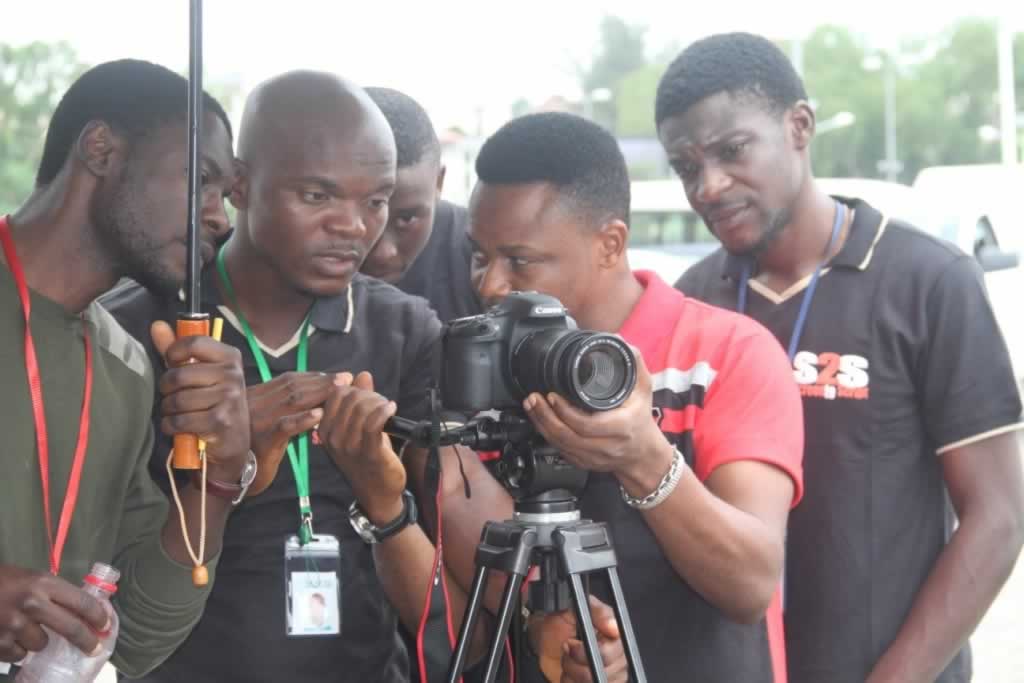WHAT IS FILMMAKING?
THE FILMMAKING PROCESS
The filmmaking process involves three main production stages, however it has five stages in all, viz: Development stage, Pre-production stage, Production stage, Post-production stage, and Marketting/ Distribution stage.
The development stage precedes production. In this stage the screen writer writes the script and the producer hires the director and key actors, prepares a budget and shooting schedule, and raises the necessary fund to pay for the production.
The next stage, pre-production involves the remaining preparatory work before production begins. During preproduction the producer approves the final version of the script, and the rest of the cast and crew members are hired, and shooting locations are finalised. The director, assistant director, unit production manager, and producer plan the sequence for shooting the individual scenes. Possibly, the actors hold rehearsals. The producer, director, and designers work together to outline the visual look of the film- how the scenes will be staged, set construction and decoration, costumes, make-up and hair design, and lighting etc.
When preproduction is completed, production can begin. A movie is filmed scene by scene, and a scene is filmed shot by shot. These scenes and shots are not usually filmed in the order they appear in the film. This is because filming depends on factors such as whether conditions, actors availability, and the set construction schedule. Scenes that involve large complicated sets often are filmed near the end of the shooting schedule, because these sets take longer time to be completed
Preparing for a film shot involves five main operations:
1.The art department and property master(props) prepares the set furnishings and the props the actors will use.
- The actors run through their lines and movements.
3.The director of photography selects and arranges the lights.
4.The camera operator rehearses the various camera angles and movements to be used in the shot.
5.The sound crew determine the volume level and placement of microphones.
The director overseas and coordinates all these activities.
Each filmed shot is called a take. For complicated shots such as battle field sequences, the director may use multi cameras to minimize the number of takes. Even with multi cameras however, the director may require many takes before he or she is satisfied. After each take the director confers with the camera operator and production sound mixer. If the director is pleased with the performances, and if the camera and sound work are good, the director instructs that the take be printed. If it is not good, it is not printed.
In high-budget productions that involve complicated scenes, it is customary to film an entire sequence in one long master shot, which includes all the major action. Cover shots are brief shots that, edited into the master shot, give the scene proper dramatic emphasis and meaningful details from moment to moment. Cover shots includes close-ups, medium shots, long shots, tracking shots (shots in which the camera is moving while filming), and panning shots (shots in which the camera swivels while filming). Shooting this array of shots is called shooting coverage. Each cover shot, however minor, necessitates a new camera setup and a new placement of lights, microphones, and actors. Action from shot to shot must always match when edited into the film. For example, if the heroine has set down a glass with her left hand in the master shot, she must not set it down with her right hand in the close up shot.
At the end of the day, the shot the director likes are printed. The following day the director, producer, cinematographer, and editor look at these dailies. During these screenings the director and editor begin to assemble shots into scenes and scenes into a sequence. Early version of sequences, or early cuts, often contain alternative takes for certain shots. As the director and editor makes final decisions during the editing process, they eliminate the extra takes, so that the structure of the final picture emerges in the form of a rough cut. Then as scenes are polished and transitions smoothed, the rough cut gradually becomes the first cut.
During the post production work, the director and editor solves problems. For example, if a shot went out of focus for a moment in a close up, they may solve the problem by cutting to a medium shot if they do not have another satisfactory take of the close up. While editing the first cut, the director weighs the editor’s recommendations, but keeps the overall plan of the picture in mind. The producer also contributes, especially when the director and editor are considering re-shooting scenes; this may cause the picture to go over budget. When all the scenes are shot and the first cut finished, the producer may approve it, or work with the editor and/or director to make further refinements. The final product is the final cut. The film is then ready for sound editing, finalizing of the musical score, and mixing.
The last stage of the film-making process, is the marketing and distribution stage; getting the film to the final consumer.

